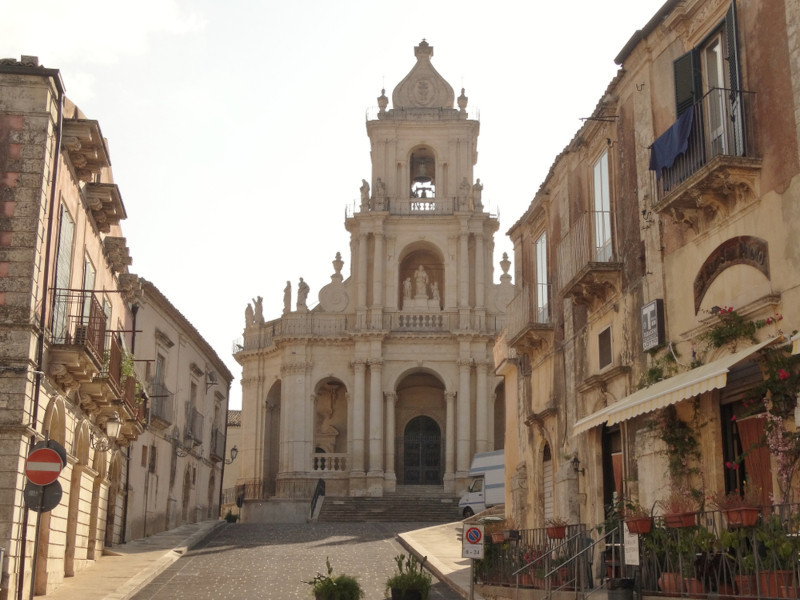Palazzolo Acreide
Palazzolo Acreide (Sicilian: Palazzolu Acrèidi, in the local dialect: Palazzuolu) is a town and comune of in the Province of Syracuse, Sicily (Italy). It is 43 kilometres (27 mi) from the city of Syracuse in the Hyblean Mountains. History The area around Palazzolo Acreide was settled by humans since very ancient times. In the 11th-10th centuries BC, the Siculi lived here in small villages. The town occupies the site of the ancient Akrai (Latin Acrae), founded by Syracuse about 664 BC. The city was important as it controlled the paths of communication with the towns on the southern coast of the island. According to Thucydides, the Syracusans defeated the Athenians here in 413 BC. In the treaty between the Romans and Hiero II of Syracuse in 263 BC it was assigned to the latter. After the Roman conquest, it became a civitas stipendiaria, and was still prospering in the course of the early Christian age. The old city was probably destroyed by the Arabs, in the first half of the 9th century. The new city was built around a Norman castle, no longer extant. An earthquake in 1693 destroyed almost all of the city, which was slowly rebuilt in the following centuries. Economy The economy of Palazzolo Acreide relies mainly on agriculture (cereals) and farming of cattle and sheep. Main sights Church of St. Sebastian (15th century, rebuilt after the 17th century). Basilica of San Paolo (18th century). Church of Santa Maria della Medaglia. Church of San Michele (15th to 16th centuries, rebuilt after 1693). It is a typical example of "minor Sicilian Baroque", with a notable belfry closed by a cupola. Church of the Assunta or Immacolata (18th century). It has a convex façade and a single nave interior, with rich decorations. It houses a statue of the Madonna, in Carrara white marble, sculpted by Francesco Laurana in 1471–72. Church of St. Anthony (18th century), unfinished, with a neo-Romanesque façade. The Chiesa Madre ("Mother Church"). The first document attesting its existence dates from 1215, when the church was dedicated to St. Nicholas. It was largely rebuilt and redecorated after the earthquake of 1693, with a Neo-classicist façade. The interior is on the Latin cross plan, with a nave and two aisles decorated with precious polychrome marbles. Antonino Uccello's Museum House. It houses artifacts and remains from the peasant civilization of Sicily, including working tools, glass paintings, wax statues and others. Palazzo Cappellani, where the Archaeological Museum is site (currently to be opened). Grotto of St. Conrad, a small church carved in a cliff, on the site where the hermit Corrado Confalonieri retired in the 14th century. Traces of mosaics and the base of the altar remain. Ancient city The ancient city lies on the hill above the modern town, the approach to it being defended by quarries, in which tombs of all periods have been discovered. The auditorium of the small theater is well preserved, though nothing of the stage remains. Close to it are ruins of other buildings, which bear, without justification, the names Naumachia, Odeum (perhaps a bath establishment) and Palace of Hiero. The water supply was obtained by subterranean aqueducts. In the cliffs of the Monte Pineta to the south are other tomb chambers, and to the south again are the curious bas-reliefs called Santoni or Santicelli, mutilated in the 19th century by a peasant proprietor, which appear to be sepulchral also. Near here too is the necropolis of the Acrocoro della Torre, where many sarcophagi have been found. About 5 miles (8 km) north lies Buscemi, near which a sacred grotto has been discovered; and also a church cut in the rock and surrounded by a cemetery. References External links Official website (Italian) Sites about the city (English) Saint Paul (Italian) Ancient Ruins (English) UNESCO World Heritage Sites (English) Tourist Attractions and History (English) Image gallery (Italian)

